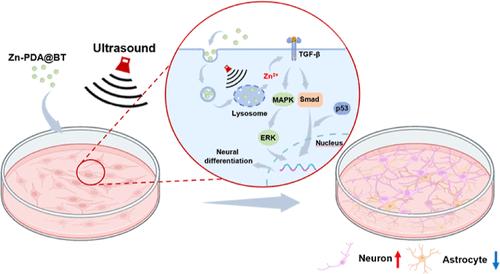Our official English website, www.x-mol.net, welcomes your
feedback! (Note: you will need to create a separate account there.)
Trojan Horse Strategy for Wireless Electrical Stimulation-Induced Zn2+ Release to Regulate Neural Stem Cell Differentiation for Spinal Cord Injury Repair
ACS Nano ( IF 15.8 ) Pub Date : 2024-11-11 , DOI: 10.1021/acsnano.4c08863 Shuwei Han, Dapeng Zhang, Yanbing Kao, Xiaolong Zhou, Xianzheng Guo, Wencan Zhang, Mingshan Liu, Haosheng Chen, Xiaohong Kong, Zhijian Wei, Hong Liu, Shiqing Feng
ACS Nano ( IF 15.8 ) Pub Date : 2024-11-11 , DOI: 10.1021/acsnano.4c08863 Shuwei Han, Dapeng Zhang, Yanbing Kao, Xiaolong Zhou, Xianzheng Guo, Wencan Zhang, Mingshan Liu, Haosheng Chen, Xiaohong Kong, Zhijian Wei, Hong Liu, Shiqing Feng

|
Due to the uncertain differentiation of neural stem cells (NSCs), replenishing lost neurons by endogenous neural differentiation to repair spinal cord injury (SCI) remains challenging. The electrical stimulation-induced drug release is a promising approach for the localized and controlled release of drugs to regulate the differentiation of NSCs into neurons. Here, we developed Zn-PDA@BT nanoparticles acted as Trojan Horse to enter cells through endocytosis for Zn2+-controlled release therapy by the potentials generated by the piezoelectric effect. Due to the presence of polydopamine (PDA), under ultrasound stimulation, the electrical signal derived from the piezoelectric effect of barium titanate nanoparticles can be attracted to the surface of Trojan Horse nanoparticles to facilitate the controlled release of Zn2+. And Zn2+ bonded with PDA can increase the intracellular Zn2+ concentration within mouse-derived NSCs (mNSCs) to regulate the differentiation of mNSCs, which could enhance excitatory neuronal differentiation and inhibit astrocyte differentiation of mNSCs by activating the TGF-β and p53 pathways. More importantly, this Trojan Horse therapy allowed mNSCs to differentiate into mature neurons in 5 days, while the natural differentiation process took 10 days. Moreover, the transplantation of mNSC-ingested Zn-PDA@BT nanoparticles effectively replenished lost neurons at the damaged site and promoted function recovery after SCI in vivo, demonstrating the great potential of electrical stimulation-induced Zn2+ release for SCI repair.
中文翻译:

无线电电刺激诱导的 Zn2+ 释放调节神经干细胞分化以修复脊髓损伤的特洛伊木马策略
由于神经干细胞 (NSC) 的分化不确定,通过内源性神经分化补充丢失的神经元以修复脊髓损伤 (SCI) 仍然具有挑战性。电刺激诱导的药物释放是一种很有前途的药物局部和受控释放以调节 NSCs 向神经元分化的方法。在这里,我们开发了 Zn-PDA@BT 纳米颗粒作为特洛伊木马,通过压电效应产生的电位通过内吞作用进入细胞,进行 Zn2+ 控释治疗。由于聚多巴胺 (PDA) 的存在,在超声刺激下,钛酸钡纳米颗粒的压电效应产生的电信号可以被吸引到特洛伊木马纳米颗粒的表面,以促进 Zn2+ 的受控释放。与 PDA 结合的 Zn2+ 可以增加小鼠来源的 NSCs (mNSC) 内的细胞内 Zn2+ 浓度,以调节 mNSCs 的分化,从而通过激活 TGF-β 和 p53 通路来增强兴奋性神经元分化并抑制 mNSCs 的星形胶质细胞分化。更重要的是,这种特洛伊木马疗法让 mNSCs 在 5 天内分化成成熟的神经元,而自然分化过程需要 10 天。此外,mNSC 摄入的 Zn-PDA@BT 纳米颗粒移植有效补充了受损部位丢失的神经元,促进了体内 SCI 后的功能恢复,证明了电刺激诱导的 Zn2+ 释放对 SCI 修复的巨大潜力。
更新日期:2024-11-12
中文翻译:

无线电电刺激诱导的 Zn2+ 释放调节神经干细胞分化以修复脊髓损伤的特洛伊木马策略
由于神经干细胞 (NSC) 的分化不确定,通过内源性神经分化补充丢失的神经元以修复脊髓损伤 (SCI) 仍然具有挑战性。电刺激诱导的药物释放是一种很有前途的药物局部和受控释放以调节 NSCs 向神经元分化的方法。在这里,我们开发了 Zn-PDA@BT 纳米颗粒作为特洛伊木马,通过压电效应产生的电位通过内吞作用进入细胞,进行 Zn2+ 控释治疗。由于聚多巴胺 (PDA) 的存在,在超声刺激下,钛酸钡纳米颗粒的压电效应产生的电信号可以被吸引到特洛伊木马纳米颗粒的表面,以促进 Zn2+ 的受控释放。与 PDA 结合的 Zn2+ 可以增加小鼠来源的 NSCs (mNSC) 内的细胞内 Zn2+ 浓度,以调节 mNSCs 的分化,从而通过激活 TGF-β 和 p53 通路来增强兴奋性神经元分化并抑制 mNSCs 的星形胶质细胞分化。更重要的是,这种特洛伊木马疗法让 mNSCs 在 5 天内分化成成熟的神经元,而自然分化过程需要 10 天。此外,mNSC 摄入的 Zn-PDA@BT 纳米颗粒移植有效补充了受损部位丢失的神经元,促进了体内 SCI 后的功能恢复,证明了电刺激诱导的 Zn2+ 释放对 SCI 修复的巨大潜力。


















































 京公网安备 11010802027423号
京公网安备 11010802027423号